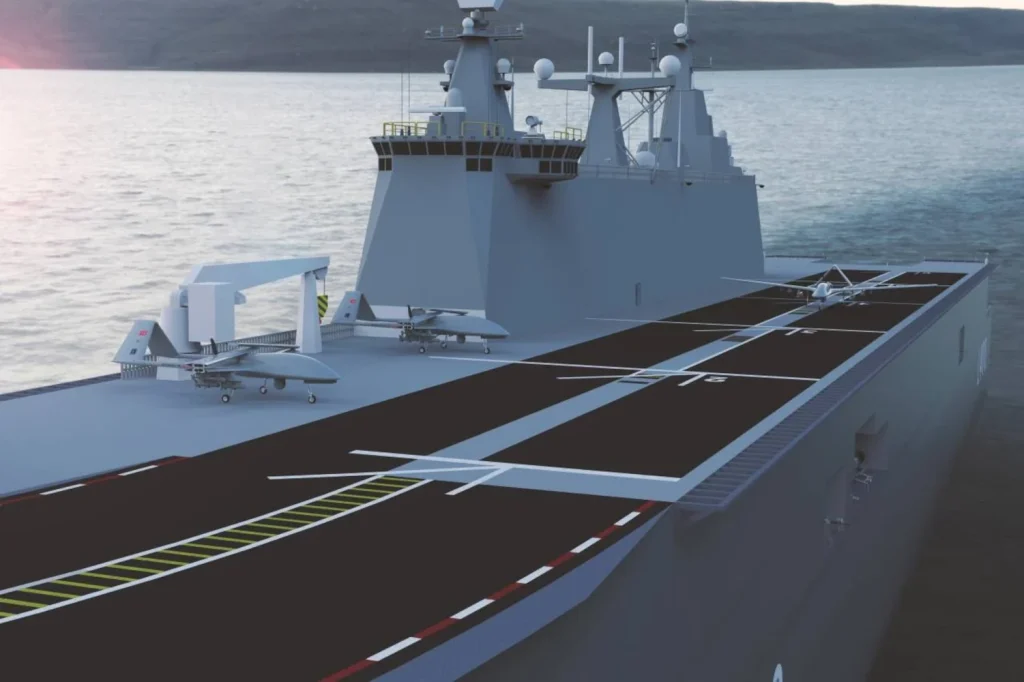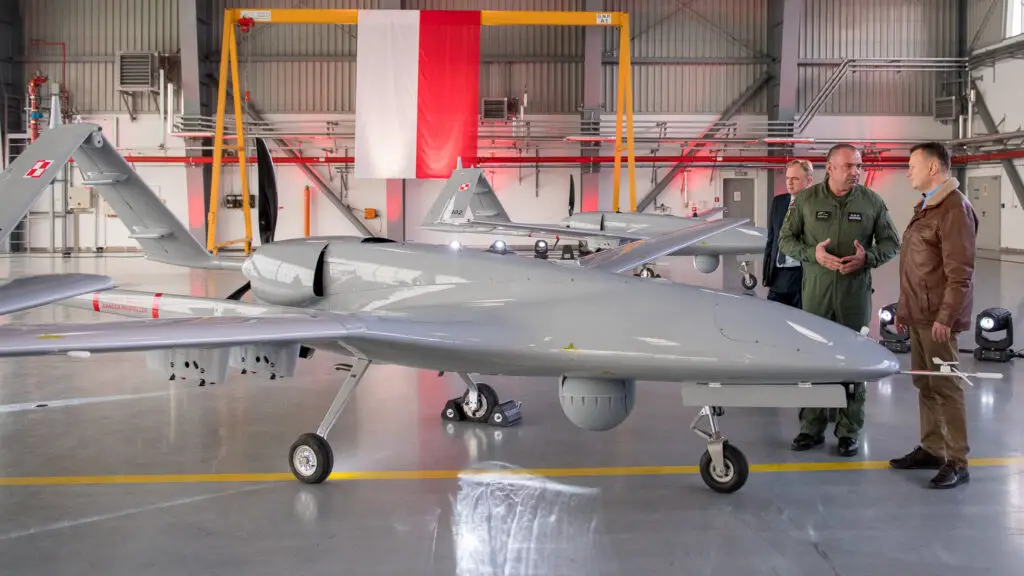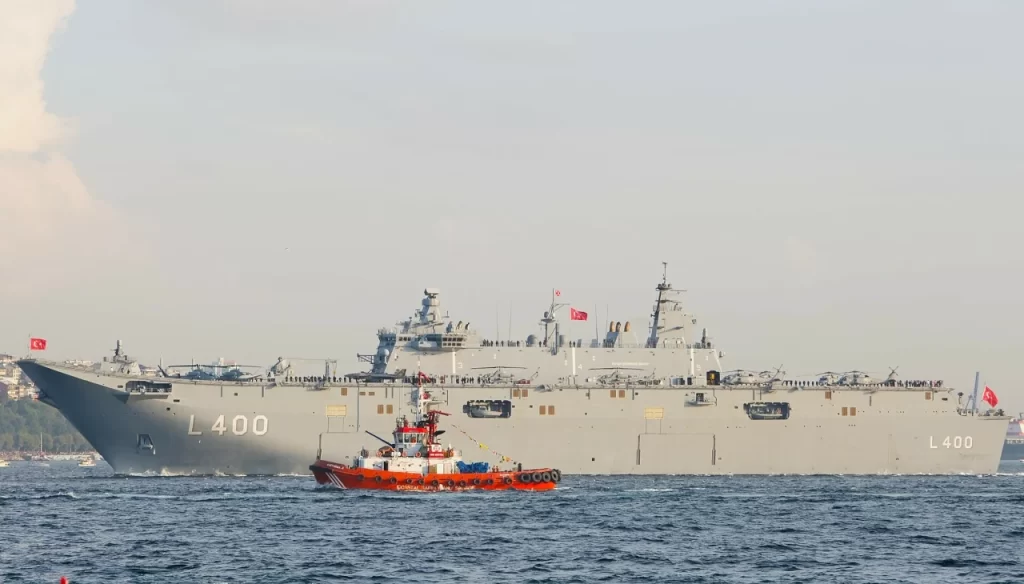The inaugural flight of the unmanned aircraft Bayraktar TB3 occurred on October 27. The flight occurred at the AKINCI Flight Training and Test Centre in the Çorlu district of Tekirdağ, northwest of Turkey. This development coincides with the October 23 announcement by Baykar, the drone’s manufacturer, regarding the conclusion of TB3’s takeoff and landing trials. The specifics of the experiments that the Turkish manufacturer performed are unknown. The online-hosted official video exclusively captures the drone in flight.
The forthcoming drone will serve as the principal aircraft of the Anadolu helicopter carrier, which is the flagship vessel of the Turkish Navy. TB3 capabilities will also include intelligence gathering regarding maritime activities.
The Bayraktar TB3 is a variation of the Turkish business Baykar’s TB2 model. The first photographs of the new unmanned aircraft meant for naval warships were unveiled in March of this year after several years of development.

During the Ukraine-Russia war, Kyiv tried to use the TB2 version in combat, but they performed dismally, and most of them were shot down by the Russian air defences. During the Nagorno-Karabakh war, Azerbaijan put it second to Israeli loitering systems, and Turkish troops and allies in Syria and Libya had mixed results as they were susceptible to small-arms fire. TB2s have been proven successful only when the opposition lacks anti-aircraft weapons, common in counter-terrorism operations. The Polish government drew harsh criticism when it inducted six TB2s ordered before the Russian-Ukraine crisis.
Despite its cheap and overhyped products, Baykar lags in sales, too. The Swedish Institute of International Affairs (SIPRI) reports that 69 military and dual-use UAVs with the capacity to carry up to 250 kg during takeoff were sold globally in 2022. Data from national licensing registries for defence systems show that manufacturers from the United States dominated two-thirds of this medium-sized UAV market segment. At the same time, the Czech company Primoco UAV controlled one-third of it.
As for the TB3’s specs, its wingspan is 14 metres, and its length is 8.35 metres. The drone can carry up to 280 kilograms and take off with a maximum weight of 1450 kilograms. The maker says this is a big improvement over the TB2’s data, which showed that it could carry up to 130 kilograms of cargo and have a maximum takeoff weight of 750 kilograms. The TB3 will have a 128 kW PD170 engine made in the country. This will let it fly up to 1800 km from the takeoff point and loiter over a target for 24 hours.

Six hardpoints under the drone’s wings can hold different weapons, such as laser-guided missiles, bombs, and anti-tank missiles. Besides being able to attack, the TB3 will also be used for data gathering, surveillance, and reconnaissance. The Turkish military can use satellite transmission tools to send maritime drones beyond the visual range. This gives the Anadolu helicopter carrier a wider “field of view” over large parts of the ocean. The TB3 can send data from headquarters to units in the field because it can carry different modular systems.
The Turkish naval drone requires very small takeoff and landing runways, making it appropriate for deployment on aircraft carriers and large-deck landing ships. Its Short Take Off and Landing (STOL) capability extends the UAV operating capabilities to small, remote landing surfaces on land, giving Turkish forces additional flexibility in ground operations.
Baykar plans to start mass-producing the TB3 next year. It will be used on TCG Anadolu, Turkey’s most important ship. The drone’s first flight shows that Turkish production of robotic aircraft is still going strong and that Ankara wants to build a mothership for drones. The Anadolu was ordered in 2015, and its keel was laid in 2018. It was launched the next year. It entered service in May of this year. The ship is a Landing Helicopter Dock (LHD), which means it has a big deck and hangars at the back of it. For assault missions, the Turkish flagship ship can carry tanks, amphibious vehicles, armoured carriers, and planes.
The mothership role is a compromise because the TCG Anadolu was originally meant to be a floating base for American fighter planes like the F-35B or AV-8B Harrier II. Later, the US took Turkey out of the F-35 programme in 2019 because it bought Russian S-400 air defence systems.

Ankara changed its plans earlier this year because it didn’t have F-35B short takeoff and vertical landing planes to fill the deck. To make room for drones, the Anadolu had some small changes made to its design and equipment. As part of this, control posts with satellite terminals for unmanned aircraft were added so that the ship and drones could talk to each other even when they weren’t in sight. At the ship’s bow, a “rolling system” was also added to help TB3 take off. When drones land, they either hook onto an arresting wire or, for smaller planes, they fall into a safety net.
The Turkish Ministry of Defence stated earlier this year that, depending on the nature of the operation, the Anadolu can accommodate twelve crewed or uncrewed combat aircraft. Furthermore, it can be an aerial base to accommodate a squadron of helicopters or other aircraft.

The Baykar company is concurrently developing the c, an unmanned combat aircraft, alongside its efforts on the TB3. Akin to the TB3, the Kizilelma might be spotted on the deck of the Anadolu. In December of last year, the Kizilelma successfully concluded its inaugural flight. Baykar plans to commence serial production of the system the following year. Official statements indicate that this aircraft will be operational on the flagship vessel of the Turkish Navy by 2025.
Kizilelmas are engineered to execute combat operations customarily carried out by manned fighter aircraft. A Ukrainian AI-25TLT turbofan engine propels it without an afterburner, developed by the Zaporizhia-based firm Ivchenko Progress. The drone’s manoeuvrability is improved by placing canards before its primary wings. It is anticipated that subsequent iterations will possess the capability to achieve supersonic flight. Its design is low observable.
When fully fueled, a Kizilelma drone can fly for five to six hours. It possesses a combat radius exceeding 900 kilometres and a maximum altitude of 14,000 metres. The maximum payload capacity of the Kizilelma is 1,500 kilograms, with a maximum takeoff weight of 6,000 kilograms. Numerous Turkish air-to-ground and air-to-ground precision munitions and missiles are likely supported by it.
